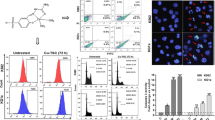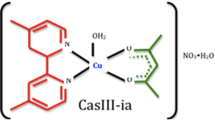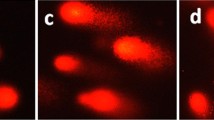Abstract
The family of Copper(II) coordination compounds Casiopeínas® (Cas) has shown antiproliferative activity in several tumour lines by oxidative cellular damage and mitochondrial dysfunction that lead to cell death through apoptotic pathways. The goal of this work is looking for the functional mechanism of CasIIgly, CasIIIia and CasIIIEa in neuroblastoma metastatic cell line SK-N-SH, a paediatric extra-cranial tumour which is refractory to several anti-carcinogenic agents. All Cas have shown higher antiproliferative activity than cisplatin (IC50 = 123 μM) with IC50 values of 18, 22 and 63 µM for CasIIgly, CasIIIEa and CasIIIia, respectively. At low concentrations and early times (4 h), these compounds cause a disruption of the mitochondrial transmembrane potential (Δψm). Concomitantly, an important depletion of intracellular glutathione and an increase of reactive oxygen species (ROS) hydrogen peroxide and radical superoxide were observed. On the other side, the lower cytotoxic effect of Casiopeínas on cultures of human peripheral blood lymphocytes (IC50 CasIIgly = 1720 µM, IC50 CasIIIEa = 3860 µM and IC50 CasIIIia = 4700 µM) show the selectivity of these compounds over the tumour cells compared with the non-transformed cells. Chemically, glutathione (GSH) interacts with Casiopeínas® through the coordination of sulphur atom to the metal centre, process which facilitates the electron transfer to get Cu(I), GSSG and the posterior production of ROS. Additionally, the molecular structure of CasIIIia as nitrate is reported. These results have shown that the anticarcinogenic activity of Casiopeínas® on neuroblastoma SK-N-SH is through mitochondrial apoptosis due to the enhanced pro-oxidant environment promoted by the presence of the coordination copper compounds.
Graphical Abstract











Similar content being viewed by others
References
Agilent (2013) CrysAlis PRO and CrysAlis RED. Agilent Technologies, Yarnton
Alemón-Medina R, Breña-Valle M, Muñoz-Sánchez JL, Gracia-Mora I, Ruiz-Azuara L (2007) Induction of oxidative damage by copper-based antineoplastic drugs (Casiopeínas®). Cancer Chemother Pharmacol 60:219–228. doi:10.1007/s00280-006-0364-9
Alemón-Medina R, Muñoz-Sánchez JL, Ruiz-Azuara L, Gracia-Mora I (2008) Casiopeína IIgly induced cytotoxicity to HeLa cells depletes the levels of reduced glutathione and is prevented by dimethyl sulfoxide. Toxicol Vitro 22:710–715. doi:10.1016/j.tiv.2007.11.011
Alemón-Medina R, Bravo-Gómez ME, Gracia-Mora MI, Ruiz-Azuara L (2011) Comparison between the antiproliferative effect and intracellular glutathione depletion induced by Casiopeína IIgly and cisplatin in murine melanoma B16 cells. Toxicol Vitro 25:868–873. doi:10.1016/j.tiv.2011.02.007
Becco L, Rodríguez A, Bravo ME, Prieto MJ, Ruiz-Azuara L, Garat B, Moreno V, Gambino D (2012) New achievements on biological aspects of copper complexes Casiopeínas®: interaction with DNA and proteins and anti-Trypanosoma cruzi activity. J Inorg Biochem 109:49–56. doi:10.1016/j.jinorgbio.2012.01.010
Becco L, García-Ramos JC, Azuara L, Gambino D, Garat B (2014) Analysis of the DNA interaction of copper compounds belonging to the Casiopeínas® antitumoral series. Biol Trace Elem Res 161:210–215. doi:10.1007/s12011-014-0098-1
Bertrand B, Casini A (2014) A golden future in medicinal inorganic chemistry: the promise of anticancer gold organometallic compounds. Dalton Trans 43:4209–4219. doi:10.1039/C3DT52524D
Biasutto L, Dong LF, Zoratti M, Neuzil J (2010) Mitochondrially targeted anti-cancer agents. Mitochondrion 10:670–681. doi:10.1016/j.mito.2010.06.004
Bica L, Meyerowitz J, Parker SJ, Caragounis A, Du T, Paterson BM, Barnham KJ, Crouch PJ, White AR, Donelly PS (2011) Cell cycle arrest in cultured neuroblastoma cells exposed to a bis(thiosemicarbazonato) metal complex. Biometals 24:117–133. doi:10.1007/s10534-010-9380-7
Biedler JL, Helson L, Barbara A (1973) Morphology and growth, tumorigenicity, and cytogenetics of human neuroblastoma cells in continuous culture. Cancer Res 33(2643):2652
Bielski BHJ, Cabelli DE, Arudi RL, Ross AB (1985) Reactivity of HO2/O2- radicals in aqueous solution. J Phys Chem Ref Data 14:1041–1100. https://srd.nist.gov/JPCRD/jpcrd285.pdf
Bravo-Gómez ME, García-Ramos JC, Gracia-Mora I, Ruiz-Azuara L (2009) Antiproliferative activity and QSAR study of copper(II) mixed chelate [Cu(N–N) (acetylacetonato)]NO3 and [Cu(N–N) (glycinato)]NO3 complexes, (Casiopeínas®). J Inorg Biochem 103:299–309. doi:10.1016/j.jinorgbio.2008.10.006
Bravo-Gómez ME, Dávila-Manzanilla S, Flood-Garibay J, Muciño-Hernández MA, Mendoza A, García-Ramos JC, Moreno-Esparza R, Ruiz-Azuara L (2012) Secondary ligand effects on the cytotoxicity of several Casiopeína’s Group II compounds. J Mex Chem Soc 56:85–92
Carvallo-Chaigneau F, Gómez-Ruiz C, Rodríguez-Aguilera E, Macías-Rosales L, Cortés-Barberena E, Cedillo-Peláez C, Gracia-Mora I, Ruiz-Azuara L, Madrid-Marina V, Constantino-Casas F (2008) Casiopeina III-ia induces apoptosis in HCT-15 cells in vitro through caspase-dependent mechanisms and has antitumor effect in vivo. Biometals 21:17–28. doi:10.1007/s10534-007-9089-4
Chao MP, Majeti R, Weissman IL (2011) Programmed cell removal: a new obstacle in the road to developing cancer. Nat Rev Cancer 12:58–67. doi:10.1038/nrc3171
Combaret V, Boyault S, Lacono L, Berejon S, Rousseau R, Puisieux A (2008) Effect of bortezomib on human neuroblastoma: analysis of molecular mechanisms involved in cytotoxicity. Mol Cancer 7:50. doi:10.1186/1476-4598-7-50
De Vizcaya-Ruiz A, Rivero-Müller A, Ruiz-Ramírez L, Kass GE, Kelland LR, Orr RM, Dobrota M (2000) Induction of apoptosis by a novel copper-based anticancer compound, casiopeina II, in L1210 murine leukaemia and CH1 human ovarian carcinoma cells. Toxicol Vitro 14:1–5. doi:10.1016/S0887-2333(99)00082-X
Derenzini M, Pession A, Farabegoli F, Treré D, Badiali M, Dehan P (1989) Relationship between interphasic nucleolar organizer regions and growth rate in two neuroblastoma cell lines. Am J Pathol 134:925–932
Downes JM, Whelan J, Bosnich B (1981) Biological analogs. Spectroscopic characteristics of mercapto- and disulfide-copper(II) coordination in relation to type I proteins. Inorg Chem 20:1081–1086. doi:10.1021/ic50218a025
Dukes CE, Masina F (1949) Classification of epithelial tumours of the bladder. Br J Urol 21:273–295. doi:10.1111/j.1464-410X.1949.tb10787.x
Farrugia L (1999) WinGX suite for small-molecule single-crystal crystallography. J Appl Crystallogr 32:837–838. doi:10.1107/S0021889899003039
Galindo-Murillo R, Ruíz-Azuara L, Moreno-Esparza R, Cortés-Guzmán F (2012) Molecular recognition between DNA and a copper-based anticancer complex. Phys Chem Chem Phys 14:15539–15546. doi:10.1039/C2CP42185B
Galindo-Murillo R, García-Ramos JC, Ruiz-Azuara L, Cheatham TE III, Cortés-Guzmán F (2015) Intercalation processes of copper complexes in DNA. Nucleic Acids Res 43:5364–5376. doi:10.1093/nar/gkv467
García-Ramos JC, Toledano-Magaña Y, Talavera-Contreras LG, Flores-Alamo M, Ramírez-Delgado V, Morales-León E, Ortiz-Frade L, Gutiérrez AG, Vázquez-Aguirre A, Mejía C, Carrero JC, Laclette JP, Moreno-Esparza R, Ruiz-Azuara L (2012) Potential cytotoxic and amoebicide activity of first row transition metal compounds with 2,9-bis-(2′,5′-diazahexanyl)-1,10-phenanthroline (L1). Dalton Trans 41:10164–10174. doi:10.1039/C2DT30224A
Goldstein S, Czapski G (1983) Mechanisms of the dismutation of superoxide catalyzed by the copper(II) phenanthroline complex and of the oxidation of the copper(I) phenanthroline complex by oxygen in aqueous solution. J Am Chem Soc 105:7276–7280. doi:10.1021/ja00363a012
Guan S, Zhao Y, Lu J, Yu Y, Sun W, Mao X, Chen Z, Xu X, Pan J, Sun S, Yang J (2016) Second-generation proteasome inhibitor carfilzomib sensitizes neuroblastoma cells to doxorubicin-induced apoptosis. Oncotarget. doi:10.18632/oncotarget.12427
Gutiérrez AG, Vázquez-Aguirre A, García-Ramos JC, Flores-Alamo M, Hernández-Lemus E, Ruiz-Azuara L, Mejía C (2013) Copper(II) mixed chelate compounds induce apoptosis through reactive oxygen species in neuroblastoma cell line CHP-212. J Inorg Biochem 126:17–25. doi:10.1016/j.jinorgbio.2013.05.001
Haglund C, Åleskog A, Nygren P, Gullbo J, Höglund M, Wickström M, Larsson R, Lindhagen E (2012) In vitro evaluation of clinical activity and toxicity of anticancer drugs using tumor cells from patients and cells representing normal tissues. Cancer Chemother Pharmacol 69:697–707. doi:10.1007/s00280-011-1746-1
Hernández-Lemus E, Gutiérrez AG, Vázquez-Aguirre A, Palma-Tirado ML, Ruiz-Azuara L, Mejía C (2013) Analysis of apoptotic and autophagic pathways in neuroblastoma by treatment with copper compounds. Neuroblastoma. InTech, Croatia, pp 145–161
Ireland CM, Pittman SM, Jones SL, Harnett PR (1994) Establishment of an in vitro model for cisplatin resistance in human neuroblastoma cell lines. Anticancer Res 14:2397–2403
Ishikawa T, Wrigth CD, Ishizuka H (1994) GS-X pump is functionally overexpressed in cis-diamminedichloroplatinum(II)-resistant human leukemia HL-60 cells and down-regulated by cell differentiation. J Biol Chem 269:29085–29093
Kachadourian R, Brechbuhl HM, Ruiz-Azuara L, Gracia-Mora I, Day BJ (2010) Casiopeína IIgly-induced oxidative stress and mitochondrial dysfunction in human lung cancer A549 and H157 cells. Toxicology 268:176–183. doi:10.1016/j.tox.2009.12.010
Kamencic H, Lyon A, Paterson PG, Juurlink BHJ (2000) Monochlorobimane fluorometric method to measure tissue glutathione. Anal Biochem 286:35–37. doi:10.1006/abio.2000.4765
Leal-García M, García-Ortuño L, Ruiz-Azuara L, Gracia-Mora I, Luna-Delvillar J, Sumano H (2007) Assessment of acute respiratory and cardiovascular toxicity of Casiopeinas in anaesthetized dogs. Basic Clin Pharmacol Toxicol 101:151–158. doi:10.1111/j.1742-7843.2007.00038.x
Li LC, Sheng JR, Mulherkar N, Prabhakar BS, Meriggioli MN (2008) Regulation of apoptosis and Caspase-8 expression in neuroblastoma cells by isoforms of the IG20 gene. Cancer Res 15:7352–7361. doi:10.1158/0008-5472.CAN-07-6311
Maris JM (2010) Recent advances in neuroblastoma. New Engl J Med 10:2202–2211. doi:10.1056/NEJMra0804577
Matthay KK, Villablanca JG, Seeger RC, Stram DO, Harris RE, Ramsay NK, Swift P, Shimada H, Black CT, Brodeur GM, Gerbing RB, Reynolds CP (1999) Treatment of high-risk neuroblastoma with intensive chemotherapy, radiotherapy, autologous bone marrow transplantation, and 13-cis-Retinoic acid. N Engl J Med 341:1165–1173. doi:10.1056/NEJM199910143411601
Mejía C, Ruiz-Azuara L (2008) Casiopeinas IIgly and IIIia induce apoptosis in medulloblastoma cells. Pathol Oncol Res 14:467–472. doi:10.1007/s12253-008-9060-x
Modica-Napolitano JS, Keshav K (2004) Mitochondrial dysfunction in cancer. Mitochondrion 4:755–762. doi:10.1016/j.mito.2004.07.027
Muhammad N, Guo Z (2014) Metal-based anticancer chemotherapeutic agents. Curr Opin Chem Biol 19:144–153. doi:10.1016/j.cbpa.2014.02.003
National Cancer Institute (2015) PDQ neuroblastoma treatment. National Cancer Institute, Bethesda. Date last modified 03/22/2013. http://www.cancer.org/cancer/neuroblastoma/detailedguide/neuroblastoma-survival-rates. Accessed 25 Nov, 2015
Paterson BM, Donelly PS (2011) Copper complexes of bis(thiosemicarbazones): from chemotherapeutics to diagnostic and therapeutic radiopharmaceuticals. Chem Soc Rev 40:3005–3018. doi:10.1039/C0CS00215A
Patterson MK Jr (1979) Measurement of growth and viability of cells in culture. Method Enzymol 58:141–152
Rivero-Müller A, De Vizcaya-Ruiz A, Plant N, Ruiz L, Dobrota M (2007) Mixed chelate copper complex, Casiopeina IIgly, binds and degrades nucleic acids: a mechanism of cytotoxicity. Chem Biol Interact 165:189–199. doi:10.1016/j.cbi.2006.12.002
Ruggiero A, Trombatore G, Triarico S, Arena R, Ferrara P, Scalzone M, Pierri F, Riccardi R (2013) Platinum compounds in children with cancer: toxicity and clinical management. Anticancer Drugs 24:1007–1019. doi:10.1097/CAD.0b013e3283650bda
Ruiz-Azuara L, Patente, Enero 26 (1994) no. 172967; SECOFI 18802. PI (1990) Patente Dic.9 (1993) no. 172248; US Patent Ap 21 (1992) Number 5, 107, 005. Re35, 458, Feb. 18 (1997); U. S. Patent Pat. No. 5,576,326. Nov. 19 (1996) [®Trade Mark: Casiopeína. Reg. 407543 SECOFI (1992), renewal (2002), (2012)]
Ruiz-Azuara L (1996) Copper amino acidate diimine nitrate compounds and their methyl derivatives and a process for preparing them. Ap. N. 07/628,628; 5,576,326
Ruiz-Azuara L (1997) Process to obtain new mixed copper aminoacidate complexes from phenylatephenanthroline to be used as anticancerigenic agents. Ap N. 07/628,843; RE 35,458, Feb. 18, 1992.
Ruiz-Azuara L, Bravo-Gómez ME (2010) Copper compounds in cancer chemotherapy. Curr Med Chem 17:3606–3615. doi:10.2174/092986710793213751
Ryan J, Tiunan A, Fay J, Bryan K, Meehan M, Greevey L, Lynch J, Bray IM, O’Meara A, Davidoff AM, Stallings RL (2012) MicroRNA-204 increases sensitivity of neuroblastoma cells to cisplatin and is associated with a favourable clinical outcome. Br J Cancer 107:967–976. doi:10.1038/bjc.2012.356
Santini C, Pellei M, Gandin V, Porchia M, Tisato F, Marzano C (2014) Advances in copper complexes as anticancer agents. Chem Rev 114:815–862. doi:10.1021/cr400135x
Sava G, Jaouen G, Hillard EA, Bergamo A (2012) Targeted therapy vs. DNA-adduct formation-guided design: thoughts about the future of metal-based anticancer drugs. Dalton Trans 41:8226–8234. doi:10.1039/C2DT30075C
Schafer FQ, Buetner GR (2001) Redox environment of the cell as viewed through the redox state of the glutathione disulfide/glutathione couple. Free Rad Biol Med 30:1191–1212. doi:10.1016/S0891-5849(01)00480-4
Serment-Guerrero J, Cano-Sánchez P, Reyes-Pérez E, Velázquez-García F, Bravo-Gómez ME, Ruiz-Azuara L (2011) Genotoxicity of the copper antineoplastic coordination complexes casiopeinas. Toxicol Vitro 25:1376–1384. doi:10.1016/j.tiv.2011.05.008
Sheldrick GM (2008) A short history of SHELX. Acta Cryst Sect A Found Crystallogr 64:112–122. doi:10.1107/s0108767307043930
Sirri V, Pession A, Treré D, Montaniou L, Derenzini M (1995) Proportionally constant quantitative transmission of nucleolin and protein B23 in cycling cancer cells. Clin Mol Pathol 48:M264–M268
Tovar-Tovar A, Ruiz-Ramírez L, Campero A, Romerosa A, Moreno-Esparza R, Rosales-Hoz J (2004) Structural and reactivity studies on 4,4′-dimethyl-2,2′-bipyridine acetylacetonate copper(II) nitrate (CASIOPEINA III-ia®) with methionine, by UV–visible and EPR techniques. J Inorg Biochem 98:1045–1053. doi:10.1016/j.jinorgbio.2004.02.023
Trejo-Solís C, Palencia G, Zúñiga S, Rodríguez-Ropón A, Osorio-Rico L, Sánchez L, Gracia-Mora I, Márquez-Rosado L, Sánchez A, Moreno-García ME, Cruz A, Bravo-Gómez ME, Ruiz-Ramírez L, Rodríguez-Enríquez S, Sotelo J (2005) Cas IIgly induces apoptosis in glioma C6 cells in vitro and in vivo through caspase-dependent and caspase-independent mechanisms. Neoplasia 7:563–574. doi:10.1593/neo.04607
Trejo-Solís C, Jiménez-Farfán D, Rodríguez-Enríquez S, Fernández-Valverde F, Cruz-Salgado A, Ruiz-Azuara L, Sotelo J (2012) Copper compound induces autophagy and apoptosis of glioma cells by reactive oxygen species and jnk activation. BMC Cancer 12:156. doi:10.1186/1471-2407-12-156
Valencia-Cruz AI, Uribe-Figueroa LI, Galindo-Murillo R, Baca-López K, Gutiérrez AG, Vázquez-Aguirre A, Ruiz-Azuara L, Hernández-Lemus E, Mejía C (2013) Whole genome gene expression analysis reveals casiopeína-induced apoptosis pathways. PLoS ONE 8:e54664. doi:10.1371/journal.pone.0054664
Vértiz G, García-Ortuño LE, Bernal JP, Bravo-Gómez ME, Lounejeva E, Huerta A, Ruiz-Azuara L (2012) Pharmacokinetics and hematotoxicity of a novel copper-based anticancer agent: casiopeina III-Ea, after a single intravenous dose in rats. Fundam Clin Pharmacol 28:78–87. doi:10.1111/j.1472-8206.2012.01075.x
Vo KT, Matthay KK, Neuhaus J, London WB, Hero B, Ambros PF, Nakagawara A, Miniati D, Wheeler K, Pearson AD, Cohn SL, DuBois SG (2014) Clinical, biologic, and prognostic differences on the basis of primary tumor site in neuroblastoma: a report from the international neuroblastoma risk group project. J Clin Oncol 32:3169–3176. doi:10.1200/JCO.2014.56.1621
Weil JA, Bolton JR, Wertz JE (1994) Electron spin resonance: elementary theory and practical applications. Wiley, New York
Yu F, Zhu X, Feng C, Wang T, Hong Q, Liu Z, Tang S (2011) Proteomics-based identification of spontaneous regression-associated proteins in neuroblastoma. J Peditr Surg 46:1948–1955. doi:10.1016/j.jpedsurg.2011.06.024
Zhang H, Thomas R, Oupicky D, Peng F (2008) Synthesis and characterization of new copper thiosemicarbazone complexes with an ONNS quadridentate system: cell growth inhibition, S-phase cell cycle arrest and proapoptotic activities on cisplatin-resistant neuroblastoma cells. J Biol Inorg Chem 13:47–55. doi:10.1007/s00775-007-0299-6
Zhang S, Wei JS, Li SQ, Badgett TC, Song YK, Agarwal S, Coarfa C, Tolman C, Hurd L, Liao H, He J, Wen X, Liu Z, Thiele CJ, Westermann F, Asgharzadeh S, Seeger RC, Maris JM, Guidry Auvil JM, Smith MA, Kolaczyk ED, Shohet J, Khan J (2016) MYCN controls an alternative RNA splicing program in high-risk metastatic neuroblastoma. Cancer Lett 371(2):214–224. doi:10.1016/j.canlet.2015.11.045
Acknowledgements
This work was supported with Grants from PAPIIT-UNAM 204511 and 218013, CONACYT 179119, ICyTDF-PIN VII-32. JCGR and YTM are grateful to DGAPA for postdoctoral Grant. AGG thanks CONACyT for the scholarship Grant. Authors acknowledge Gonzalo Acero for technical support.
Author information
Authors and Affiliations
Corresponding authors
Additional information
Juan Carlos García-Ramos and Anllely Grizett Gutiérrez have contributed equally to the work.
Rights and permissions
About this article
Cite this article
García-Ramos, J.C., Gutiérrez, A.G., Vázquez-Aguirre, A. et al. The mitochondrial apoptotic pathway is induced by Cu(II) antineoplastic compounds (Casiopeínas®) in SK-N-SH neuroblastoma cells after short exposure times. Biometals 30, 43–58 (2017). https://doi.org/10.1007/s10534-016-9983-8
Received:
Accepted:
Published:
Issue Date:
DOI: https://doi.org/10.1007/s10534-016-9983-8




